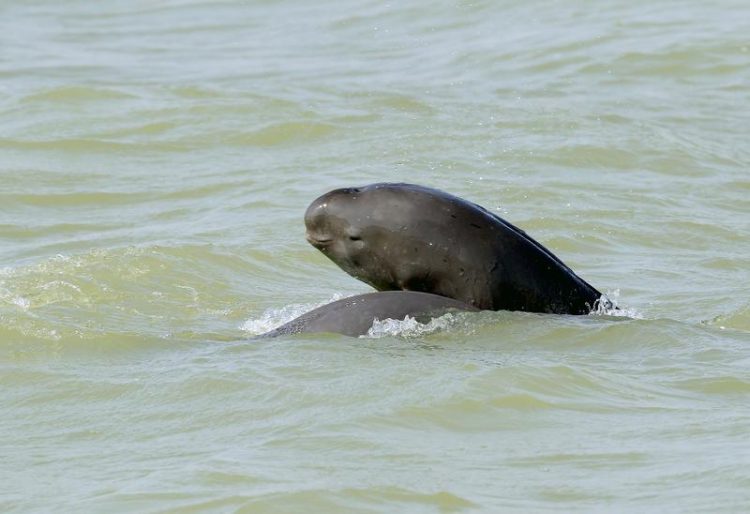Endangered giants: large freshwater species most threatened with extinction on the planet

The Yangtze Finless Porpoise is listed as critically endangered on the IUCN Red List of Threatened Species. Photo: Huigong Yu
Many large aquatic vertebrates, referred to as freshwater megafauna, cover long distances between their breeding and feeding grounds. To ensure their safe passage, they are dependent on free-flowing waters. However, this makes them vulnerable to the increasing fragmentation of river catchments caused by damming.
The Russian sturgeon, for example, has lost 70 per cent of its spawning grounds in the Caspian Sea basin and its entire Black Sea basin spawning grounds over the last 60 years due to dam construction. The boom in dam construction also affects many other species, such as the Amazonian manatee, the Ganges river dolphin and the Mekong giant catfish – these species are now classified as threatened. “The fragmentation of habitats is one of the central threats to freshwater megafauna, as well as overexploitation” explained Fengzhi He.
The IGB researcher is the lead author of the study on the disappearance of large vertebrates from rivers and lakes, published recently in WIREs Water. According to The International Union for Conservation of Nature (IUCN) Red List of Threatened Species, more than half of the world’s large-bodied vertebrates weighing more than 30 kg that live in freshwater ecosystems are threatened.
Yet, freshwater megafauna species play key roles in their respective ecosystems: owing to their size, most are at the top of the food chain, meaning that a large proportion of creatures in the local ecosystem would be affected by their extinction.
The mode of life of the Eurasian beaver and the North American beaver, for example, induces them to shape entire river courses, affecting not only biochemical and hydrological processes, but also in-stream and riparian assemblages; in the Everglades, the American alligator creates and maintains small ponds, providing habitats for a large number of plants and smaller animals.
“The importance of freshwater megafauna for biodiversity and humans cannot be overstated,” stressed Fengzhi He. Together with colleagues from IUCN, the University of Tübingen and Queen Mary University of London, Fengzhi He describes in this publication which factors pose threats to freshwater megafauna. Besides the obstruction and fragmentation of water bodies following dam construction, these factors include overexploitation, environmental pollution, habitat destruction, species invasion and the changes associated with climate change.
According to the authors, megafauna species are highly susceptible to external factors owing to their long lifespan, large body size, late maturity and low fecundity. Despite the fact that many megafauna species are under great threat, they have been largely neglected in previous research and conservation actions.
Fengzhi He and his co-authors call for research focusing on the distribution patterns, life history and population dynamics of freshwater megafauna. Freshwaters are among the most endangered ecosystems on the planet, where biodiversity is declining faster than in marine and terrestrial realms. For this reason, it is all the more important to develop sustainable nature conservation strategies for freshwater ecosystems and their megafauna.
Link to study
http://onlinelibrary.wiley.com/doi/10.1002/wat2.1208/full
He, F., Zarfl, C., Bremerich, V., Henshaw, A., Darwall, W., Tockner, K. and Jähnig, S. C. (2017), Disappearing giants: a review of threats to freshwater megafauna. WIREs Water, e1208. doi:10.1002/wat2.1208
Contacts
Fengzhi He
Leibniz-Institute of Freshwater Ecology and Inland Fisheries (IGB)
Müggelseedamm 310, 12587 Berlin
fengzhi.he@igb-berlin.de
Dr. Sonja Jähnig
Leibniz-Institute of Freshwater Ecology and Inland Fisheries (IGB)
Justus-von-Liebig-Str. 7, 12489 Berlin
sonja.jaehnig@igb-berlin.de
+49 (0)30 6392 4085
About IGB:
Work at IGB combines basic research with preventive research as a basis for the sustainable management of freshwaters. In the process, IGB explores the structure and function of aquatic ecosystems under near-natural conditions and under the effect of multiple stressors. Its key research activities include the long-term development of lakes, rivers and wetlands under rapidly changing global, regional and local environmental conditions, the development of coupled ecological and socio-economic models, the renaturation of ecosystems, and the biodiversity of aquatic habitats. Work is conducted in close cooperation with universities and research institutions from the Berlin/Brandenburg region as well as worldwide. IGB is a member of the Forschungsverbund Berlin e.V., an association of eight research institutes of natural sciences, life sciences and environmental sciences in Berlin. The institutes are members of the Leibniz Association.
Media Contact
All latest news from the category: Ecology, The Environment and Conservation
This complex theme deals primarily with interactions between organisms and the environmental factors that impact them, but to a greater extent between individual inanimate environmental factors.
innovations-report offers informative reports and articles on topics such as climate protection, landscape conservation, ecological systems, wildlife and nature parks and ecosystem efficiency and balance.
Newest articles

Time to Leave Home? Revealed Insights into Brood Care of Cichlids
Shell-dwelling cichlids take intense care of their offspring, which they raise in abandoned snail shells. A team at the Max Planck Institute for Biological Intelligence used 3D-printed snail shells to…

Smart Fabrics: Innovative Comfortable Wearable Tech
Researchers have demonstrated new wearable technologies that both generate electricity from human movement and improve the comfort of the technology for the people wearing them. The work stems from an…

Going Steady—Study Reveals North Atlantic’s Gulf Stream Remains Robust
A study by the University of Bern and the Woods Hole Oceanographic Institution in the USA concludes that the ocean circulation in the North Atlantic, which includes the Gulf Stream,…



